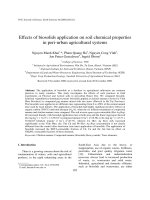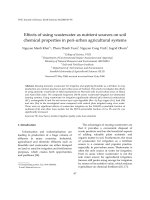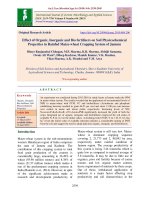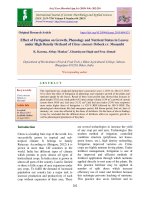Effect of organic and inorganic sources of nutrients on soil chemical properties and nutrient availabilities under direct seeded rice in inceptisols of Bastar plateau zone
Bạn đang xem bản rút gọn của tài liệu. Xem và tải ngay bản đầy đủ của tài liệu tại đây (160.44 KB, 7 trang )
Int.J.Curr.Microbiol.App.Sci (2020) 9(5): 2592-2598
International Journal of Current Microbiology and Applied Sciences
ISSN: 2319-7706 Volume 9 Number 5 (2020)
Journal homepage:
Original Research Article
/>
Effect of Organic and Inorganic Sources of Nutrients on Soil Chemical
Properties and Nutrient Availabilities under Direct Seeded Rice in
Inceptisols of Bastar Plateau Zone
Poornima Sahu, T. Chandrakar*, G. K. Sharma, A. K. Thakur and M. Paikra
SG College of Agriculture & Research Station, Jagdalpur (Chhattisgarh)-494005, India
*Corresponding author
ABSTRACT
Keywords
Organic and
inorganic sources,
Chemical properties
and nutrient
availability
Article Info
Accepted:
18 April 2020
Available Online:
10 May 2020
A field experiment was carried out at S.G. College of Agriculture and Research Station,
Jagdalpur, Chhattisgarh during Kharif 2016 to study the effect of organic and inorganic sources
of nutrients on soil chemical properties and nutrient availabilities under direct seeded rice in
Inceptisols of Bastar plateau zone. The experiment was conducted in randomized block design
with twelve treatments and four replications. The 100% NPK i.e. recommended dose of
fertilizers were 100:60:40 kg N: P2O5: K2O/ ha for rice crop. Soil samples were collected from
the top soil surface (0-15 cm) of all the four replications before and after Kharif 2016 and
analyzed for chemical properties and nutrients availabilities. The highest pH (6.70) was
recorded in 50% NPK +5 t FYM + ZnSO4 @ 25 kg/ ha + lime 3 q/ha (T12) whereas the lowest
pH (6.1) was recorded in 100% NPK. A slight increase in soil pH was observed in all the
treatments which received FYM and lime and decrease was recorded in treatments which
received inorganic nutrient sources as compared to the initial. The continuous application of
organic materials along with fertilizers significantly increased the soil organic carbon as
compared to the application of fertilizers alone. The use of organic manure like FYM with
chemical fertilizers increased the availability of macro (N, P, K, S, Ca, and Mg) and micro (Zn)
nutrients in soil over chemical fertilizer alone.
Introduction
Rice (Oryza sativa L.) occupies a pride place
among the food crops cultivated in India
which has the largest area among rice
growing countries and stands second in the
production. In India, during the past three
decades, intensive agriculture involving high
yielding varieties of rice has led to heavy
withdrawal of nutrients from the soil.
Use of organic manures in present agriculture
is decreasing day by day. Its utility has not
only improved the physical, chemical and
biological properties of soil but also
maintained the good soil health.
Long-term experiment has shown that crop
residues incorporation, farm yard manures
and green manures increased soil +organic
carbon and nutrient availability as compared
2592
Int.J.Curr.Microbiol.App.Sci (2020) 9(5): 2592-2598
to the nitrogenous fertilizers alone (Lado et
al., 2004). The advantage of combining
organic and inorganic sources of nutrients in
integrated nutrient management has been
proved superior to the use of each component
separately (Palaniappan and Annadurai,
2007). The use of organics plays a major role
in maintaining soil health due to buildup of
soil organic matter, beneficial microbes. The
conjunctive application of organics with
inorganic sources of nutrient reduces the
dependence on chemical inputs and it not only
acts as a source of nutrient but also provides
micronutrient as well as modifies the soil
physical behaviour and increases the
efficiency of applied nutrients (Pandey et al.,
2007). Integrated application of inorganic
fertilizers and organic manures with
micronutrients helped in increasing the
availability of nutrients and in sustaining and
restoring soil fertility in its available nutrients
and
major
physical
and
chemical
characteristics of the soil. Utilization of
indigenous organic sources, viz. farmyard
manure (FYM), obnoxious weeds and green
leaf manures may serve as alternatives or
supplements to chemical fertilizers, and help
in increasing the productivity of the ricebased cropping system in all zones of the
country.
Materials and Methods
The field experiment was conducted in
midland field under long term fertilizer
experiment, AICRIP-Dryland Agriculture at
SG College of Agriculture and Research
Station, Kumhrawand, Jagdalpur (C.G.)
during Kharif 2016. The experimental soils
was sandy loam having pH 6.3 and EC 0.02
dSm1, organic carbon status 0.56%, 186 kg
ha1 of alkaline KMnO4 N, 21.4 kg ha-1 P, 178
kg ha1 of NH4OAC- K, 33 kg ha1 of
Turbidimetric- S, 92 and 58 kg ha-1 of EDTA
titrated- Ca & Mg, respectively and 1.03 ppm
DTPA extractable zinc. The experiment was
conducted with twelve treatments namely
T1(control), T2(100% NPK i.e. 100:60:40
kg/ha N: P2O5: K2O), T3(100% PK), T4(100%
NK), T5(100% NP), T6(100% NPK+5 t
FYM),
T7(100%
NPK+5
t
FYM+
ZnSO4@25kg ha-1), T8(100% NPK+5 t
FYM+ ZnSO4@25kg ha-1 + Lime 3 q ha-1), T9
(50% NPK), T10(50% NPK + 5 t FYM), T11
(50% NPK + 5 t FYM+ ZnSO4@25kg
ha-1) and T12 (50% NPK + 5 t FYM+
ZnSO4@25kg ha-1+ Lime 3 q ha-1). The
experiment was laid out in randomized block
design (RBD) with four replications. Soil
samples were collected from the top soil
surface (0-15 cm) of all the four replications
before and after Kharif 2016 and analyzed for
chemical
properties
and
nutrients
availabilities using standard procedures.
Results and Discussion
pH
The pH of the soil was statistically influenced
by different treatments (Table 1). The pH of
the soil ranged from 6.11 to 6.70. The highest
(6.70) value was recorded in 50% NPK +5 t
FYM + ZnSO4 @ 25 kg/ ha + lime 3 q/ha
(T12) whereas the lowest (6.1) value was
recorded in 100% NPK. A slight increase in
soil pH was observed in all the treatments as
compared to the initial (6.59) soil pH studied
during the starting of the experiment. This
was ascribed to the neutralizing effect of lime
in the field. This was supported by the
findings of Parvathi et al., (2013).
Organic carbon
The continuous application of organic
materials along with fertilizers significantly
increased the soil organic carbon as compared
to the application of fertilizers alone (Table
1). The highest (0.83 %) value was observed
in 100% NPK +5 t FYM + ZnSO4 @ 25 kg/
ha (T7) followed (0.82) by % NPK +5 t FYM
2593
Int.J.Curr.Microbiol.App.Sci (2020) 9(5): 2592-2598
+ ZnSO4 @ 25 kg/ ha+ Lime 3q/ha (T8) (0.82)
where as the lowest (0.52) was observed in
100% PK (T3). Organic carbon plays an
important role in maintaining soil health and
its increase during the period of
experimentation shows that use of fertilizers
has contributed in improving the soil health.
The highest value of organic content i.e.
0.83% in 100% NPK+5 t FYM + ZnSO4 @ 25
kg/ ha treatment can be assigned to the annual
use of FYM @ 5 ton ha-1 during the period of
experimentation. This also indicates that if
fertilizer use is integrated with manure,
substantial improvement in soil health can be
expected. The similar results were also found
by Sharma and Sharma (2002), Kumar et al.,
(2001) and Antil et al., (2011).
Available nitrogen
The combine application of manure and
fertilizer exhibited a significant effect on
available nitrogen in the soil. The 100% NPK
+ 5 t FYM (T6) treated plot had significantly
greater available Nitrogen (264.2 kg/ha)
followed by 100% NPK + 5 t FYM +
ZnSO4@25kg/ha (T7) treated plot as
compared to control and other treatments
plots. The 100% NPK + 5 t FYM (T6) and
100% NPK + 5 t FYM + ZnSO4@25kg/ha
(T7) treatments registered 56.4% and 47.3%
higher available nitrogen than the control. A
perusal of the data (Table 1) revealed that
available nitrogen varied from 150.1 kg/ ha
under control (T1) to 275.6 kg/ ha under 100%
NPK + 5 t FYM (T6). Application of chemical
fertilizers with organic manures increased
available nitrogen over other treatments as
well as control.
Application of 50 and 100% NPK (T9 & T2),
100% NP (T5) and 100% NK (T4) and 100%
PK (T3)significantly increased the available
nitrogen content in soil over control.
Similarly, incorporation of organic manures
along with chemical fertilizers also increased
available nitrogen content over control. The
highest available nitrogen (264.2 kg ha-1) was
found in the plots which received 100% NPK
+ 5 t FYM followed by 100% NPK + 5 t
FYM + ZnSO4@25kg/ha (T7) (248.8 Kg ha-1).
Amongst sources of nutrients, FYM with
inorganics fertilizer proved best as compare to
inorganics alone.
The lower available nitrogen in control plot
(168.9 kg ha-1) is a result of mining of
available nitrogen with continuous cropping
without fertilization over a long period of
time. Increase in available nitrogen with
organics is attributed to its direct addition
through organics as FYM contained 264.2 kg
ha-1available nitrogen. The favorable soil
conditions viz. organic carbon, porosity,
water holding capacity etc. might have helped
in the mineralization of soil nitrogen leading
to buildup of higher available nitrogen. The
results are in conformity with the findings of
Singh et al., (2007) and Urkurkar et al.,
(2010).
Available phosphorus
The available phosphorus was significantly
influenced by the fertilizer and organic
manure applied over the cropping years. The
50% NPK + 5 t FYM + ZnSO4@25kg ha-1
(T11) recorded significantly higher available
phosphorus as compared to its value in other
treatments. Available Phosphorus content of
soil was increased as compared to its initial
status. The 100% NPK+ 5 t FYM (T6) also
recorded significantly higher available
phosphorus than control and other treatments.
The 50% NPK + 5 t FYM + ZnSO4@25kg
ha-1 (T11) and 100% NPK+ 5 t FYM (T6)
registered 118.6% and 107.4% higher
available phosphorus than the control,
respectively. The data given in table 1
revealed that the available phosphorus content
of soil during Kharif 2016 varied from 9.4 to
31.3 kg ha-1amongst different treatments.
2594
Int.J.Curr.Microbiol.App.Sci (2020) 9(5): 2592-2598
Graded doses of chemical fertilizers also
increased the available phosphorus contents in
soil over control. Among the plots treated
with FYM, zinc sulphate, lime and RDF
recorded highest available phosphorus content
followed by FYM plus RDF.
The organic matter forms a cover on
sesquioxides and makes them inactive and
thus reduces the phosphate fixing capacity of
the soil, which ultimately, helps in release of
ample quantity of phosphorus. Similar result
was found by Tolanur and Badanur (2003).
Available potassium
The available potassium was significantly
affected by long-term application of inorganic
fertilizer and manure. The available K in
100% NPK + 5 t FYM were significantly
higher than other treatments. Fertilizer plus
manure application (100% NPK + 5 t FYM)
increased available potassium by 43.5%
followed by100% NPK +5 t FYM + ZnSO4 @
25 kg/ ha + lime 3 q/ha (T8) 37.3% as
compared to the control.
The data tabulated in Table 1 revealed that
during Kharif 2016,available K content of soil
varied from a minimum of 139.8 kg ha-1under
control to a maximum of 214.2 kg ha-1 under
100% NPK + FYM. Application of organic
manures along with chemical fertilizers
increased the available K content of soil
significantly over control. Increase in
available potassium due to addition of organic
manures may be ascribed to the reduction of
potassium fixation and release of potassium
due to interaction of organic matter with clay,
besides the direct potassium addition to the
pool of soil (Urkurkar et al., 2010). Such
increase in the content of available potassium
with the use of organics with chemical
fertilizers has also been reported by Singh et
al., (2007).
Available sulphur
The data on available sulphur content in soil
after harvest of rice crop was arranged in
Table 1. The range of available sulphur was
vary from 17.3 to 51.2 kg/ha in various
treatments. Highest available sulphur 45.7 kg
ha-1 was obtained with T11 (50% NPK + 5 t
FYM+ ZnSO4@25kg ha-1) followed by T12
(50% NPK + 5 t FYM+ ZnSO4@25kg ha-1+
Lime 3 q ha-1) (44.1 kg ha-1) and lowest (23.9
kg ha-1) in control. Continuous use of organic
and inorganic sources of nutrients since 201415 is conducive for maintaining the soil
available sulphur. The results of the present
study revealed that higher available sulphur
content were recorded in integrated nutrient
management treatments which were relatively
half does of nutrient as compared to absolute
inorganics and control.
Available calcium
The available calcium was not significantly
influenced by the fertilizer and organic
manure applied over the cropping years. The
100% NPK + 5 t FYM treatment recorded
higher (94.5 kg/ha) available calcium as
compared to its value in other treatments.
The 100% NPK + 5 t FYM(T6) and50% NPK
+ 5 t FYM+ ZnSO4@25kg ha-1+ Lime 3 q ha1
(T12) treatments registered 4.21% and 3.74%
higher available calcium than the control. The
data given in table 1 revealed that the
available calcium content of soil during
Kharif 2016 varied from 88.4 to 96.2 kg ha1
amongst different treatments.
Graded doses of chemical fertilizers also
increased the available calcium contents in
soil over control. Among the plots treated
with FYM, zinc sulphate, lime and RDF
recorded highest available calcium content
followed by FYM plus RDF. Similar result
was found by Chukwu et al., (2012).
2595
Int.J.Curr.Microbiol.App.Sci (2020) 9(5): 2592-2598
Table.1 Effect of organic and inorganic sources of nutrients on soil properties after Kharif rice harvest
Treatment
pH
OC
Available
Available
Available
Available
Available
Available
Available
%
N (kg/ha)
P2O5 (kg/ha)
K2O (kg/ha)
S (kg/ha)
Ca (kg/ha)
Mg (kg/ha)
Zn (ppm)
Control
6.28
0.57
168.9
13.4
145.6
23.9
90.7
57.3
1.00
100% NPK
6.11
0.75
200.5
22
174.7
30.7
92.2
55.3
0.98
100% PK
6.33
0.52
159.0
26.8
194.5
28.6
91.0
55.9
0.99
100% NK
6.19
0.57
197.7
16.0
190.4
23.6
91.4
55.5
0.98
100% NP
6.26
0.57
214.6
24.9
140
26.0
89.7
54.8
0.98
100% NPK+5 t FYM
6.44
0.82
264.2
27.8
209
35.4
94.5
58.4
1.04
100% NPK+5 t FYM+
6.46
0.86
248.8
24.6
200
41.7
93.8
58.8
1.09
6.62
0.87
229.9
26.7
189.8
37.9
94.3
58.8
1.10
50% NPK
6.19
0.71
189.3
19.6
162.6
32.8
90.0
56.6
0.99
50% NPK + 5 t FYM
6.45
0.76
233.3
25.5
196.3
41.3
93.2
58.5
1.04
50% NPK + 5 t FYM+ ZnSO4@25kg
6.51
0.81
231.8
29.3
190.4
45.7
92.8
59.2
1.10
6.70
0.84
242.6
26.0
189.3
44.1
94.1
59.3
1.10
CV %
1.11
7.75
5.3
12.0
4.0
14.6
1.5
2.5
2.86
CD (5%)
0.10
0.08
16.5
4.0
10.5
7.2
2.0
2.0
0.04
CD (1%)
0.13
0.10
22.2
5.4
14.1
9.7
2.7
2.8
ZnSO4@25kg ha
-1
100% NPK+5 t FYM+ ZnSO4@25kg
-1
ha + Lime 3q ha
-1
ha-1
50% NPK + 5 t FYM+ ZnSO4@25kg
ha-1+ Lime 3 q ha-1
2596
Int.J.Curr.Microbiol.App.Sci (2020) 9(5): 2592-2598
Available magnesium
The data on available Mg content in soil after
harvest of rice crop was arranged in Table 1.
The range of available Mg was vary from 53
to 61.2 kg/ha in various treatments.
Highest available Mg 59.3 kg ha-1 was
obtained with T12(50% NPK + 5 t FYM+
ZnSO4@25kg ha-1 + Lime 3 q ha-1) followed
by (59.2 kg ha-1) T11(50% NPK + 5 t FYM+
ZnSO4@25kg ha-1) treatment and lowest
(57.3 kg ha-1) in control.
Continuous use of balanced fertilizer i.e.
organic and inorganic since 2014-15 is
conducive for maintaining the soil available
Mg. The results of the present study revealed
that higher available Mg content were
recorded in integrated nutrient management
treatments which was relatively half does of
nutrient as compared to absolute inorganics
and control. Similar result was found by
Hemalatha and Chellamuthu (2013).
DTPA extractable zinc
The DTPA extractable zinc was not
significantly influenced by the fertilizer and
organic manure applied over the cropping
years. The treatment T8(100% NPK+5 t
FYM+ ZnSO4@25kg ha-1 + Lime 3 q ha-1),
T11(50% NPK + 5 t FYM+ ZnSO4@25kg ha1
) and T12(50% NPK + 5 t FYM+
ZnSO4@25kg ha-1+ Lime 3 q ha-1) were
recorded the highest (1.10 ppm) availability
of zinc. Followed by treatment 100% NPK +5
t FYM + ZnSO4 @ 25 kg/ ha (1.09 ppm).
The combine use of RDF, FYM, lime, and
zinc sulphate increase the availability of zinc
in the soil as compare to RDF alone. Even
though half does of RDF also increased the
zinc availability when that is applied with
organics nutrient. Similar result was found by
Vidyavathi (2012).
Continuous application of chemical fertilizers
with integration of the organics influence pH
of soil significantly. However, the organic
carbon content was higher in 100% NPK+5 t
FYM+ ZnSO4@25kg ha-1 treatments. The
inorganic fertilizer and organic manure
maintained and/or sustained highest levels of
available N, P, K, S, Ca, Mg, and Zn due to
its long-term application. Higher response
was observed in integrated use of organic
along with inorganic fertilizer for the nutrient
supply of rice crop and further it improves the
organic carbon and available nitrogen and
potassium content of soil.
References
Antil, R.S., Narwal, R.P., Singh, B and Singh,
J.P. 2011. Long- term effects of FYM
and N on soil health and crop
productivity under pearl millet - wheat
cropping system. Ind. J. Fert. 7: 14-32.
Chukwu, L.I., Ano, A.O. and Asawalam,
D.O. 2012. Effects of Poultry Manure
and NPK fertilizer on soil properties
and Nutrient uptake of maize (Zea mays
L.) plants growth in an ultisol.
Proceedings of the 36th Annual
Conference of the Soil Science Society
of Nigeria (SSSN) on 7th – 11th March,
2012 University of Nigeria Nsukka.
Kumar, N., Verma, L.P., Singh, Room and
Prasad, K. 2001. Soil Properties,
nutrient uptake and productivity of rice
under integrated nutrient management
system. Ann. plant Soil Res. 3(1): 112 115.
Palaniappan, S.P. and Annadurai, K. 2007.
Organic
Farming:
Theory
and
Practices, 169. Scientific Publishers,
Jodhpur.
Pandey, N., Verma, A.K., Anurag, Tripathi,
R.S.
2007.
Integrated
nutrient
management in transplanted hybrid rice
(oryza sativa). Indian J. Agron. 52(1):
40-42.
2597
Int.J.Curr.Microbiol.App.Sci (2020) 9(5): 2592-2598
Sharma, S.K. and Sharma, S.N. 2002.
Integrated nutrient management for
sustainability of rice (Oryza sativa) Wheat (Triticum aestivum) cropping
system on soil fertility. Indian J. Agril.
Sci. 70(6): 357-359.
Singh, K.P., Srivastava, T.K., Singh, P.N. and
Archana Suman. 2007. Enhancing Soil
fertility,
microbial
activity
and
Sugarcane (Saccharum Officinarum)
productivity through organics in subtropical conditions. The Indian J. Agril.
Sci. 77(2): 84-87.
Tolanur , S.I and Badanur, V.P., 2003. Effect
of integrated use of organic manure,
green manure and fertilizer nitrogen on
sustaining productivity of Rabi sorghum
– chickpea system and fertility of a
vertisol. J. Indian Soc. Soil Sci., 51: 4145.
Urkurkar, J.S., Tiwari, A., Shrikanth Chitale
and Bajpai, R.K. 2010. Influence of
long term use of inorganic and organic
manures on soil fertility and sustainable
productivity of rice (Oryza sativa) and
Wheat
(Triticum
aestivum)
in
Inceptisols. Indian J. Agril. Sci., 80. (3):
208-212.
Vidyavathi, G. S., Dasog, H. B., Babalad, N.
S., Hebsur, S. K., Gali, S. G., Patil And
Alagawadi, A. R. 2012. Nutrient Status
Of Soil Under Different Nutrient And
Crop Management Practices. Karnataka
J. Agril. Sci., 25 (2): 193-198.
How to cite this article:
Poornima Sahu, T. Chandrakar, G. K. Sharma, A. K. Thakur and Paikra, M. 2020. Effect of
Organic and Inorganic Sources of Nutrients on Soil Chemical Properties and Nutrient
Availabilities under Direct Seeded Rice in Inceptisols of Bastar Plateau Zone.
Int.J.Curr.Microbiol.App.Sci. 9(05): 2592-2598. doi: />
2598









